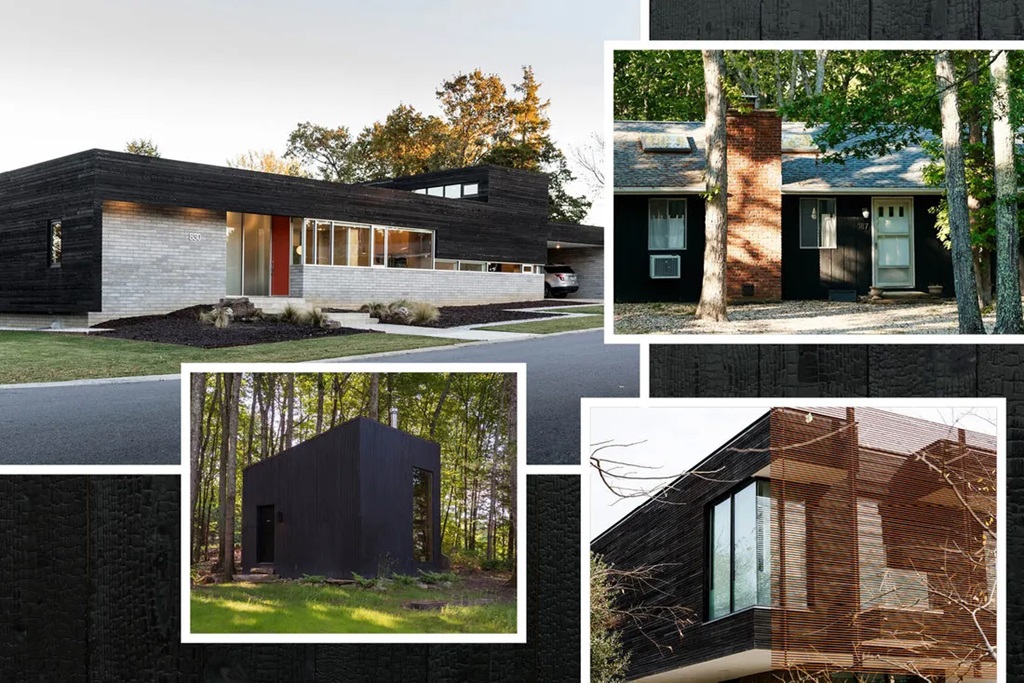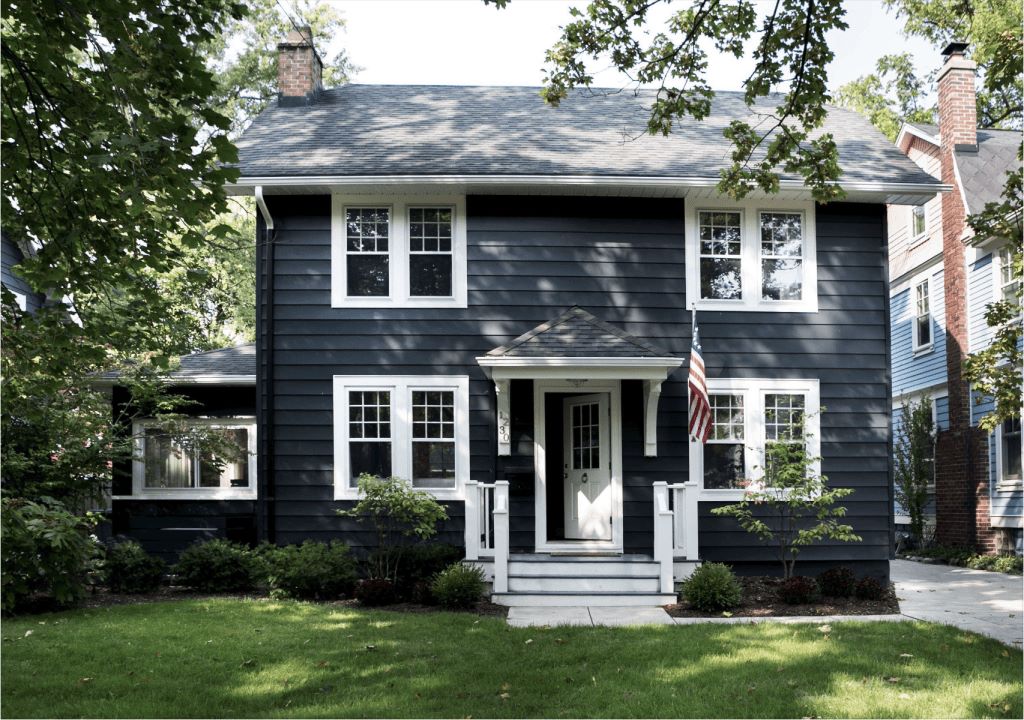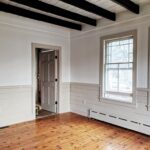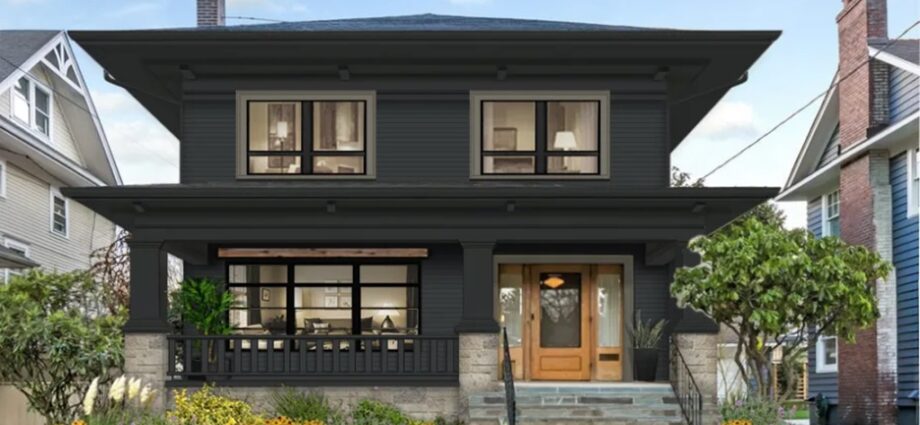Deciding to paint your home’s exterior a dark, dramatic black requires some extra planning and preparation. While the end result provides serious curb appeal, the process itself comes with unique challenges. This extensive guide takes you through everything needed to paint a black exterior house successfully.
We’ll cover choosing the right black paint, ideal weather conditions, proper surface prep, application techniques, and maintenance. Read on for pro tips that ensure your black house paintjob withstands the elements while making a seriously stylish statement.
Should You Paint Your Black Exterior House?

Painting any exterior black presents some definite advantages along with a few potential drawbacks:
Pros:
– Makes an eye-catching, elegant architectural statement. Black exteriors ooze high-end sophistication.
– Enhances and plays up decorative accents and detailing. Trims really pop against a deep black backdrop.
– Conceals exterior imperfections extremely well. Black hides flaws other colors would highlight.
– Requires less frequent repainting than lighter colors. The pigments’ density adds extra durability.
Cons:
– Can feel oppressive or overwhelming if the home’s architecture doesn’t suit the dramatic look.
-Absorbs heat from sunlight, potentially raising cooling bills in warm climates.
– Shows dirt, mildew, drips or flaws more than lighter exteriors. Upkeep is crucial.
– Provides a canvas for green mildew growth in damp climates or shady yards.
Assess your home’s size, style and placement on the lot before deciding if black fits its features and your lifestyle. Hire an architect or color consultant if unsure. climate matters too. Hot southern states may do better with a lighter color, while New England cottages pop gorgeously in black against autumn foliage backdrops.
Picking the Best Black Paint Colors
“Black” encompasses a hugely diverse paint color family. From jet black to charcoal gray, inky hues and warm, brown-based black tones offer tons of options. Compare paint swatches in various lights to pick a shade aligning with your home’s style.
Here are popular varieties of black to consider:
Jet Black: The darkest, most saturated looking black. Extremely elegant on contemporary designs. Riskiest for showing flaws.
Charcoal Black: A very deep gray-based black. More versatility for different architectural styles than flat jet black.
Warm Black: Black with red, brown or terracotta undertones. Feels a bit softer and more welcoming than cool-toned black. Great on Victorians or cottages.
Soft Black: The lightest black, softly saturated with hints of gray and brown. Low contrast helps hide imperfections well.
Blue-Black: Intense, cool-toned black with hints of navy blue. Pairs perfectly with blue gray trim colors. Stunning coastal cottages.
Green-Black: Rich black with subtle dark green undertones. Ideal for playing up nature-inspired color schemes.
Matte vs. Gloss Finish
Most black exterior paint comes in matte or flat finishes to help hide surface imperfections better. But high-gloss black works beautifully on doors and trims as an eye-catching accent.
For siding, flat or matte finishes reflect less light, absorbing more heat. Satin finishes offer a nice compromise – some sheen but not overly reflective.
How does climate factor into sheen choice? Hot southern regions often pick satin over flat to reduce heat absorption. While rainy climates need ultra-matte finishes to disguise mildew and algae buildup more easily.
What Type of Paint is Best?
Quality exterior paint engineered to withstand sun, rain, snow and temperature extremes is crucial for black houses. Basic interior paints just won’t cut it. The intensities of ultra-dark pigments demand heavy-duty binding resins so the color won’t fade or fail quickly.
Look for top-tier exterior paint lines offering advanced UV-resistant, 100% acrylic formulas. They deliver maximum pigment density with premium durability and protection. Expect to pay around $50-$60+ per gallon.
Consider These Long-Lasting Specialty Paint Options:
Silicone-Enhanced: Water-repelling silicone additives help paint better resist moisture damage. Great for damp climates.
Elastomeric: Stretches to bridge fine exterior cracks better than standard paints. Ideal for surfaces prone to expansion/contraction cracks.
Textured/Anti-Dirt: Fine textured additives make exterior paint less prone to showing dirt or stains. A smart choice for black houses.
Mildew-Resistant: Paints formulated with EPA-registered fungicides/algaecides to deter nuisance mildew growth. Helpful for shaded areas.

When is the Best Weather for Painting Black Exteriors?
Aim for ideal temperate painting conditions to get the longest-lasting, best looking results from black exterior paint. Follow these weather pointers:
– Paint when daytime temps range between 50-90°F. Avoid extreme heat or cold.
– Never apply paint if rain is expected within the next 48 hours.
– Seek lower humidity levels below 60%. High humidity lengthens drying times.
– Pick calm days with minimal wind and direct sunlight.
While sunny days may seem optimal for faster painting, direct sun actually works against freshly painted black exteriors:
– Sunlight accelerates surface drying, trapping moisture underneath. Bubbling/peeling can result.
– UV rays prematurely break down paint binders before they fully cure. Shortening paint lifespan.
Cool, cloudy days offer gentler conditions. But if painting in warmer weather, focus on painting in earlier morning hours before the sun intensifies.
Prep Work: Cleaning and Repairs
Thorough prep work makes all the difference for long-lasting, flawless looking black exterior paint. Don’t rush or cut corners here, no matter how eager you are to apply color! Proper prep ensures paint bonds tightly for maximum durability exposed to the elements.
It may feel tedious, yet exterior cleaning and repairs prevent problems down the road. Follow this systematic process:
1. Inspect Entire Surface Closely
Check for:
– Cracks or holes needing patching/sealing
– Bubbled/loose previous paint needing scraping
– Mold, mildew or dirt accumulations
– Glossy surfaces requiring sanding
2. Wash Entire Exterior
Mix:
– 1 cup bleach + 1/4 cup trisodium phosphate (TSP) per gallon of water
– Use a pressure washer or scrub entire surface by hand
– Pay extra attention to mildew-prone areas
3. Repair Exterior Damage
Fill gaps, cracks or holes with:
– Exterior-grade wood putty, filler or caulk
– Bondo or spackling for damaged siding
4. Remove Loose Paint
– Gently scrape/sand peeling spots to firm edge
– Feather rough edges smooth
5. Prime Bare Spots
– Spot prime any exposed wood or new repairs
– Use exterior primer compatible with chosen paint
With cleaning, repairs and priming finished, the surface is prepped for painting success!
Paint Application Tips
Apply black exterior paint using quality application tools and proven techniques for flawless, long-lasting results:
The Right Painting Tools
Invest in premium tools, including:
– Soft nylon or polyester brushes
– Thick 1/2”-3/4” nap roller covers
– High-capacity paint tray with built-in screen
– Lockable extension pole for second story access
Paint Top Down Methodically
Work from the top down, completing these surface areas sequentially:
– Gutters/fascias/soffits
– Doors and windows
– Corner and trim boards
– Siding
Cut In Trim First
Outline doors, windows, corners etc with trim brushes before rolling siding. This prevents brush marks and uneven coating thickness where cut-in and rolled areas meet.
Apply Multiple Thin Coats
– Roll a smooth, thin, even coat without overloading the roller
– Allow proper drying time between coats
– Build opacity and depth with 2-3 coats
Work Quickly to Control Lap Marks
Maintain a wet edge as you paint siding from top to bottom. Dry roller edges create visible lap marks. Having a second painter cutting in behind the first helps.
Inspect Between Coats
Check for patchiness, misses or thin spots after each coat dries. Touch up as needed before the next coat.
With diligent prep and care taken during painting, your black exterior will deliver curb appeal and stand up to the elements for years before needing a refresh. But what about maintaining that deep black richness long term?
Caring for Black Exteriors
While stunning, black exterior paint does demand extra care and maintenance to stay looking its absolute best. Follow these tips for keeping a sooty black exterior house looking fresh:
– Expect to repaint every 5-7 years as opposed to 8-10 years for lighter colors
– Wash regularly. Mix 1⁄4 cup laundry detergent per gallon of water. Scrub gently with a soft brush.
– Watch for mildew growth in damp climates/shaded areas and treat quickly
– Check for paint blistering or peeling annually – repaint affected areas ASAP
– Reseal joints/seams with exterior caulk every few years
– Avoid planting vines/shrubs too close. They trap moisture against siding.
Put in the proper care effort, and your sophisticated black exterior will continue wowing the neighborhood for years.
FAQs
Do black houses cost more to paint?
Yes, black exterior paint costs more than lighter shades for several reasons:
– Black requires heavier pigments and more tint to achieve very deep hues
– Advanced resin technologies help black exteriors resist fading better
– Multiple coats are often needed for full opacity with black
What colors complement black exteriors best?
Black provides an amazing neutral backdrop making other colors really stand out in contrast beautifully. Some top pairings include:
– Bright white – classic, elegant combo
– Light to mid gray – subtle sophistication
– Soft sage green – serene natural look
– Sky blue – inviting color for porches or doors
– Red brick – iconic blended accent
How much harder is black exterior maintenance?
Black shows dust, dirt, rain marks and flaws much more than lighter paint colors. Expect to:
– Repaint 25-30% sooner than light exteriors
– Wash exterior 1-2 times yearly with detergent solution
– Check for mildew growth on damp areas 1-2 times yearly
Is black exterior paint a fading trend?
Black makes a dramatic design statement that never truly fades. Its seen resurgences through history from Victorian-era styles to modern minimalism. Dark exteriors project elegance in both traditional and contemporary settings. Their rich allure continues to captivate home trends for generations.
Can black houses increase resale value?
Interesting black exteriors capture attention, standing out amid rows of generic, neutral-toned houses. Their one-of-a-kind looks often boost perceived home value. Just ensure the black truly enhances the architecture vs. clashing awkwardly. Hire a color consultant if you are unsure how black will complement your home’s features and neighborhood style.
Last Words
Painting your black exterior house makes a gorgeously high-contrast statement – when done correctly. However, the process requires additional planning and diligence compared to lighter paint colors.
Choosing an ideal black tone for your architectural style, allowing adequate drying conditions and vigilant surface prep all set the stage for success. Use top-quality 100% acrylic exterior paints to ensure your sophisticated black facade maintains its rich depth for years before needing to be refreshed.
With some extra care taken through preparation, application and maintenance, black houses deliver show-stopping, light-reflecting dimensions sure to wow. Embrace the dramatic arts of exterior painting’s dark side with these comprehensive tips from How to prepare exterior walls for painting: A comprehensive guide. Soon, you’ll have the most envy-inducing black beauty on the block!










